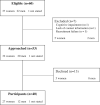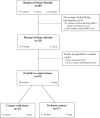National survey of donor-conceived individuals who requested information about their sperm donor-experiences from 17 years of identity releases in Sweden
- PMID: 34918081
- PMCID: PMC8888998
- DOI: 10.1093/humrep/deab275
National survey of donor-conceived individuals who requested information about their sperm donor-experiences from 17 years of identity releases in Sweden
Abstract
Study question: What characterizes the group of donor-conceived (DC) individuals who request information about their identity-release sperm donor in Sweden, and what are their experiences of disclosure, information receipt and donor contact?
Summary answer: Following three decades of identity-release donation in Sweden, few DC individuals have requested donor information with varying experiences of information receipt and donor contact.
What is known already: In 1985, Sweden was the first country worldwide to enact legislation that gave DC individuals the right to obtain identifying information about their donor. Since then, identity-release gamete donation has become available in many countries but there is limited knowledge about the individuals who request donor information.
Study design, size, duration: A nation-wide cross-sectional survey study was performed at all seven University hospitals that provided donation treatment in Sweden during 1985-2002. During this period only donor insemination to heterosexual couples was permitted. Inclusion criteria were being 18 years of age or older, conceived with donor sperm and having requested information about the donor by December 2020. Recruitment was performed during 2016-2020.
Participants/materials, setting, methods: A total of 60 individuals had requested information about their donor. Of these, 53 were approached and 40 individuals, representing 34 families, accepted study participation (75% response rate). Participants completed a postal survey with the WHO-10 well-being index and study-specific questions about experiences of disclosure, motivations for requesting donor information, receipt of information, as well as intentions and experiences of donor contact. Independent t-test and chi-square tests were used to compare ratings of participants with early and late disclosure.
Main results and role of chance: Of ∼900 DC individuals who had reached adult age, a total of 60 (≈7%) had requested information about the donor. Most of the 40 study participants (78%) made their requests within 2 years after reaching 18 years of age, or following disclosure at later ages (up to 32 years). Several participants had adult DC siblings in the family who had not requested any donor information. All except five participants received identifying information about the donor from the clinic. However, some donors had died or lacked contact information. Among those participants who were able to contact their donor, 41% had done so at the time of the study, while a third of the participants were unsure about potential contact. Several had met the donor in person and a few were in regular contact. About half of the participants had been informed about their donor conception in adolescence or adulthood (age 12-32), and there were significant differences between participants based on age at disclosure. Compared to those with early disclosure, participants with late disclosure were significantly more likely to be dissatisfied with the timing of their disclosure (P = 0.021), to react with negative emotions (P < 0.001), and to subsequently contact the donor (P = 0.047).
Limitations, reasons for caution: The limited population available for inclusion resulted in a small sample size, despite a high response rate. In addition, men's lower participation rate must be taken into consideration when interpreting the results.
Wider implications of the findings: The small number of individuals requesting information about their identity-release sperm donor is surprising. While not all DC individuals appear to be interested in donor information, it is reasonable to assume that some are unaware of their donor conception and thus unable to make informed decisions regarding their genetic origins. During the coming years, young women and men in many countries will become eligible to access identifying information about their donor. In order to meet the needs of these individuals, and to support positive outcomes for all involved parties, it is essential that adequate protocols and resources are developed.
Study funding/competing interest: Financial support from The Swedish Research Council. There are no conflicts of interest to declare.
Trial registration number: N/A.
Keywords: disclosure; donor; donor conception; donor insemination; identity release.
© The Author(s) 2021. Published by Oxford University Press on behalf of European Society of Human Reproduction and Embryology.
Figures
Comment in
-
Male Infertility.J Urol. 2022 Nov;208(5):1143-1145. doi: 10.1097/JU.0000000000002935. Epub 2022 Aug 22. J Urol. 2022. PMID: 35993122 No abstract available.
References
-
- Blyth E, Crawshaw M, Frith L, Jones C.. Donor-conceived people’s views and experiences of their genetic origins: a critical analysis of the research evidence. J Law Med 2012;19:769–789. - PubMed
-
- Bos HM, Gartrell NK.. Adolescents of the US National Longitudinal Lesbian Family Study: the impact of having a known or an unknown donor on the stability of psychological adjustment. Hum Reprod 2011;26:630–637. - PubMed
-
- Crawshaw M, Gunter C, Tidy C, Atherton F.. Working with previously anonymous gamete donors and donor-conceived adults: recent practice experiences of running the DNA-based voluntary information exchange and contact register, UK DonorLink. Hum Fertil (Camb) 2013;16:26–30. - PubMed
-
- Daniels KR, Ericsson HL, Burn IP.. The views of semen donors regarding the Swedish Insemination Act 1984. Med Law Int 1998;3:117–134. - PubMed
-
- Ethics Committee of the American Society for Reproductive Medicine. Informing offspring of their conception by gamete or embryo donation: an Ethics Committee opinion. Fertil Steril 2018;109:601–605. - PubMed
Publication types
MeSH terms
LinkOut - more resources
Full Text Sources
Medical
Research Materials
Miscellaneous



